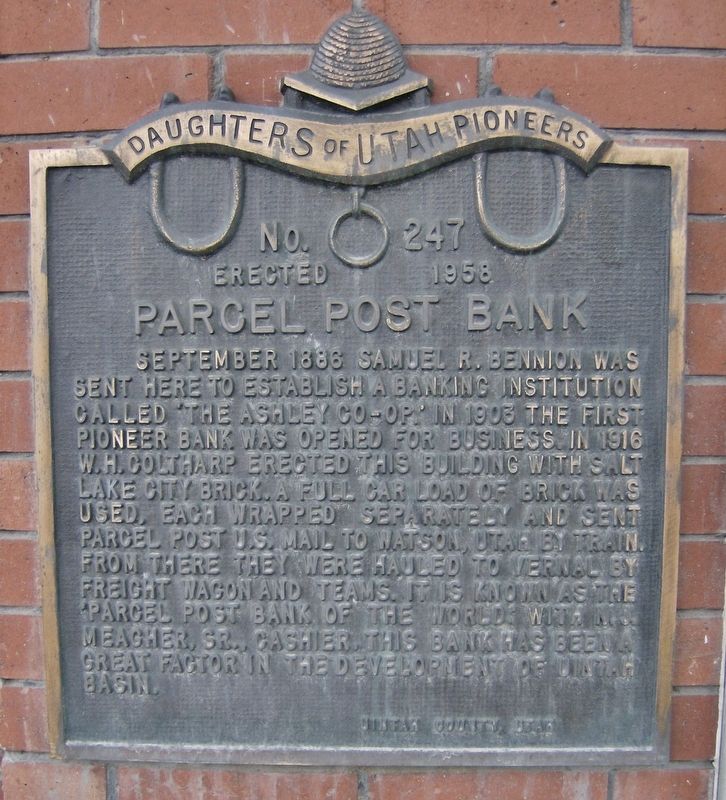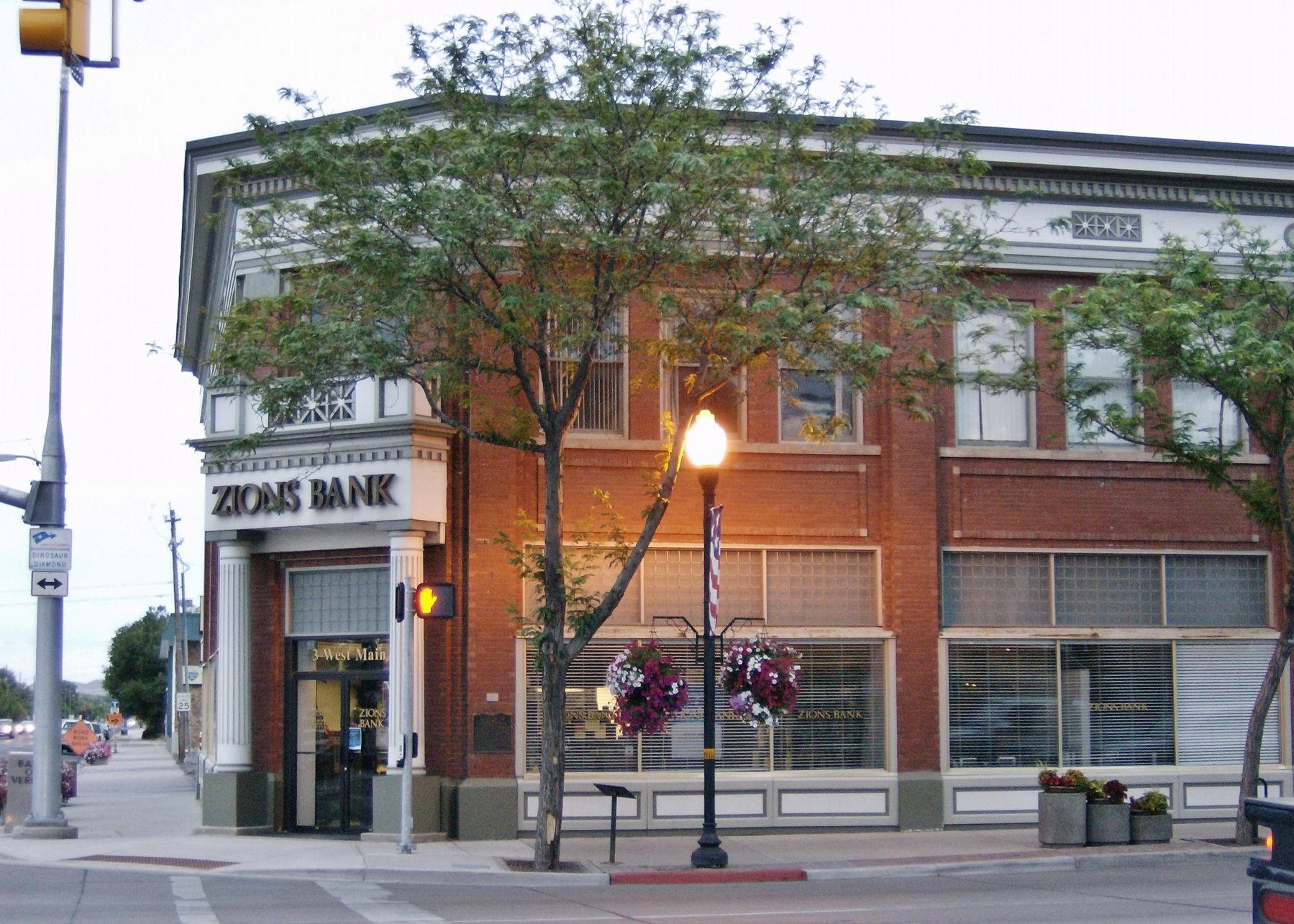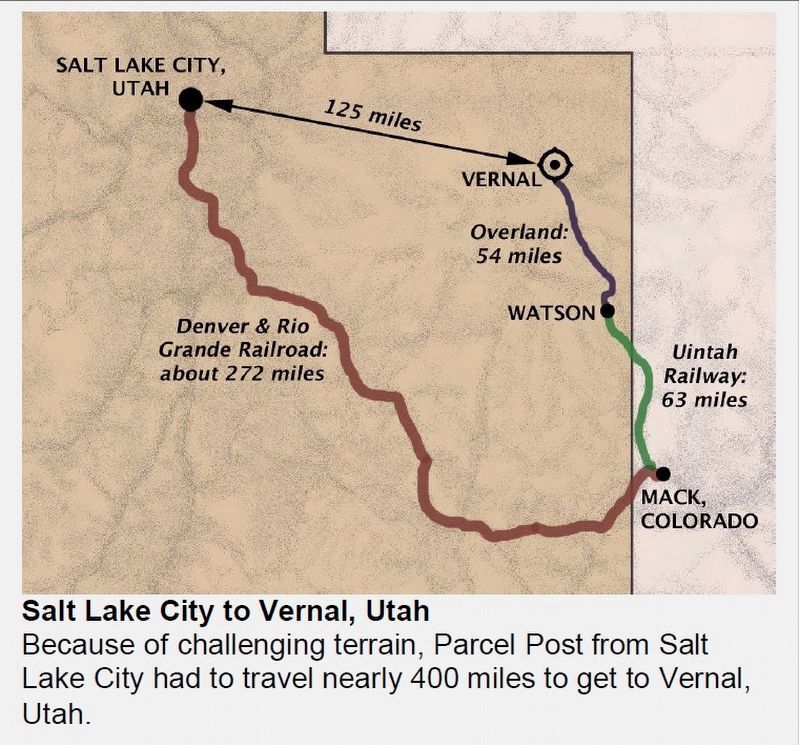Vernal in Uintah County, Utah — The American Mountains (Southwest)
Parcel Post Bank
September 1886 Samuel R. Bennion was sent here to establish a banking institution called the 'Ashley Co-op.' In 1903 the first pioneer bank was opened for business. In 1916 W.H. Coltharp erected this building with Salt Lake City brick. A full car load of brick was used, each wrapped separately and sent Parcel Post U.S. Mail to Watson, Utah by train. From there they were hauled to Vernal by freight wagon and teams. It is known as the “Parcel Post Bank of the World.” With N.J. Meagher, Sr. cashier, this bank has been a great factor in the development of Uintah Basin.
Erected 1958 by Daughters of Utah Pioneers. (Marker Number 247.)
Topics and series. This historical marker is listed in this topic list: Industry & Commerce. In addition, it is included in the Daughters of Utah Pioneers series list.
Location. 40° 27.336′ N, 109° 31.727′ W. Marker is in Vernal, Utah, in Uintah County. Marker is at the intersection of Main Street (U.S. 40) and South Vernal Avenue (U.S. 191), on the right when traveling east on Main Street. Marker is mounted at eye-level on the north wall of the Zions Bank building, near the northeast corner and main entrance. Touch for map. Marker is at or near this postal address: 3 West Main Street, Vernal UT 84078, United States of America. Touch for directions.
Other nearby markers. At least 8 other markers are within 12 miles of this marker, measured as the crow flies. Do Religion and Money Mix? (here, next to this marker); Cobble Rock Gas Station (within shouting distance of this marker); Where the Dollar has More Cents (within shouting distance of this marker); Vernal Post Office (about 400 feet away, measured in a direct line); Fort Ashley Center (about 400 feet away); Shipped Another 12,000 Hen Fruit by Parcel Post (about 400 feet away); Farm Exchange Building (approx. 0.2 miles away); Jensen (Mau-be) Ferry (approx. 11.8 miles away). Touch for a list and map of all markers in Vernal.
Also see . . .
1. Parcel Post Bank.
The new building would require more than 80,000 bricks to be shipped from Salt Lake City. At the time, wagon freighters demanded 15 cents per brick. Coltharp was determined to find a lower price, and he did. He discovered that Vernal was in a different postal code, and that each brick could be mailed via parcel post for 7 cents apiece — less than half what the freighters were offering. After the last packages left Salt Lake City, the postal service in Mack, Colorado, began questioning all the bricks going through its station. Personnel notified Washington, D.C., and regulations were quickly changed to prevent future
senders from mailing more than 200 pounds of merchandise to one addressee in a single day without special permissions. (Submitted on February 25, 2018, by Cosmos Mariner of Cape Canaveral, Florida.)
2. The Bank of Vernal: The "Parcel Post Bank".
Prior to 1913, by law, the Post Office Department could not carry packages weighing more than four pounds. Private express companies, which had begun to flourish in the mid-1800s, delivered larger packages. In 1913 the Post Office Department began accepting packages weighing up to 11 pounds for mailing via a new service called Parcel Post, bringing a world of merchandise as close as the customer’s mailbox or Post Office. (Submitted on February 25, 2018, by Cosmos Mariner of Cape Canaveral, Florida.)
3. Vernal bank built by bricks sent through the mail.
They went by rail, mostly, but the long way around. By railroad to Mack, Colorado, narrow-gauge railway back into Utah, freight wagons and ferryboats the rest of the way — 427 miles. It cost the post office a fortune. The Vernal postmaster sent a legendary telegram to Washington. And he said, "Some S.O.B. is trying to ship a whole building through the U.S. mail," except it was a little more colorful than that. (Submitted on February 26, 2018, by Cosmos Mariner of Cape Canaveral, Florida.)
Credits. This page was last revised on January 14, 2021. It was originally submitted on February 25, 2018, by Cosmos Mariner of Cape Canaveral, Florida. This page has been viewed 438 times since then and 46 times this year. Photos: 1, 2, 3, 4. submitted on February 25, 2018, by Cosmos Mariner of Cape Canaveral, Florida. • Andrew Ruppenstein was the editor who published this page.



